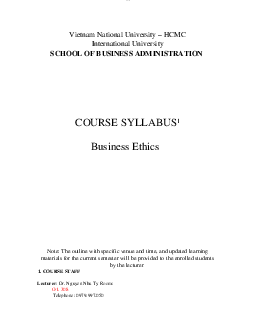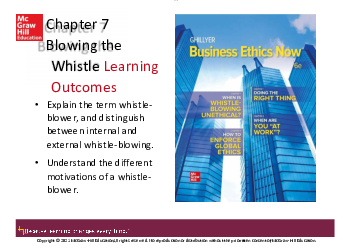










Preview text:
Vietnam National University – HCMC International University
SCHOOL OF BUSINESS ADMINISTRATION COURSE SYLLABUS1 Business Ethics
Note: The outline with specific venue and time, and updated learning
materials for the current semester will be provided to the enrolled students by the lecturer 1. COURSE STAFF
Lecturer: Dr. Nguyen Nhu Ty Room: O1. 308 Telephone: 0979.997.050 BA151IU
VNU – International University
International Business Management
School of Business Administration
E-mail: nhutynguyen@hcmiu.edu.vn Teaching Assistant: TBA Room: TBA Telephone: TBA E-mail: TBA Consultation Hours: TBA
Should the students wish to meet the staff outside the consultation hours, they are advised
to make appointment in advance. 2. COURSE INFORMATION 1
22.1 Teaching times and Locations 3 Lecture: TBA Venue: TBA 1 22.2 Units of Credit 3
This course is worth 3 credits.
2.3 Parallel teaching in the course
There is no parallel teaching involved in this course.
2.4 Relationship of this subject to others
Business ethics should be distinguished from the philosophy of business, the branch of
philosophy that deals with the philosophical, political, and ethical underpinnings of
business and economics. Business ethics operates on the premise, for example, that the
ethical operation of a private business is possible -- those who dispute that premise, such
as libertarian socialists, (who contend that "business ethics" is an oxymoron) do so by
definition outside of the domain of business ethics proper.
The philosophy of business also deals with questions such as what, if any, are the social
responsibilities of a business; business management theory; theories of individualism vs.
collectivism; free will among participants in the marketplace; the role of self interest;
invisible hand theories; the requirements of social justice; and natural rights, especially
property rights, in relation to the business enterprise.
Business ethics is also related to political economy, which is economic analysis from
political and historical perspectives. Political economy deals with the distributive
consequences of economic actions. It asks who gains and who loses from economic
activity, and is the resultant distribution fair or just, which are central ethical issues. 2 BA151IU
VNU – International University
International Business Management
School of Business Administration
According to Frederick Winter, the dean of the Katz School of Management (University of
Pittsburgh) where eliminating business ethics as a separate class is the approach, it may be
better to integrate ethics into other classes, so students see it as an integral part of other
subjects such as finance, accounting or marketing.
2.5 Approach to learning and teaching
Employing the interactive learning and problem-based teaching approach, this course
emphasises the interaction between lecturers and students. The lecture materials will be
uploaded in Blackboard to help the students to preview the materials and to concentrate on
listening and critical thinking during the lecture. This will help students to interact with the
lecturer during the classroom. The sessions for presentations and discussions comprise
company case studies as well as answering some theoretical and conceptual questions,
which help the students to see how the concepts are applied in the real international
business context. Students will present the case to the class and discuss with the peers.
3. COURSE AIMS AND OUTCOMES 3.1 Course Aims
The aim of the course is to communicate theoretical and practical insights and
developments in the fields of business ethics and sustainable business. The students learn
the characteristics of ethical issues in business. They become acquainted with the
theoretical basis of business ethics: stakeholder-theory, theories of responsibility and
normative ethical theory, intercultural ethics; as well as with theories and practices on the
implementation of business ethics.
3.2 Student Learning Outcomes
Upon successful completion of this course, students should have:
- A deep understanding of basic theoretical concepts of business ethics and sustainability
- An enhanced ability to critically examine business practices from a variety of ethical perspectives
- An increased capacity to think, speak and act in ethical ways
3.3 Teaching Strategies
The learning system in this course consists of lectures and scheduled
presentations/discussions. Lectures elaborate the appropriate theoretical content in the
textbook and readings. Classes provide a more detailed and refined analysis of both
concepts and applied materials. Classes are strongly oriented towards interactive
discussion of the text and cases. In order to gain the most from the lectures and class
activities, the assigned text/reading should be read before the lecture to participate in the discussions. 3 BA151IU
VNU – International University
International Business Management
School of Business Administration
From the second week, the students will need to form small discussion groups (3-4
students/group) which will take turns in presenting the assigned cases each week. However,
all students are required to take active part in the discussions in class. Look at articles and
clippings from business sections of relevant electronic and print media which are relevant
to the presentation topic. The students should explain how the material relates to the theory
discussed in the text. Discuss with group members as to the common strategy for sourcing,
documenting, analysing and presenting cases each week - for which a basic minimum
interaction will be necessary. For the audience, it is important that they contribute to the
case by getting additional information carefully beforehand so that they are fully familiar
with the materials, and are prepared to participate in the discussions.
4. STUDENT RESPONSIBILITIES AND CONDUCT 4.1 Workload
It is expected that the students will spend at least six hours per week studying this course.
This time should be made up of reading, research, working on exercises and problems, and
attending classes. In periods where they need to complete assignments or prepare for
examinations, the workload may be greater.
Over-commitment has been a cause of failure for many students. They should take the
required workload into account when planning how to balance study with part-time jobs and other activities. 4.2 Attendance
Regular and punctual attendance at lectures and seminars is expected in this course.
University regulations indicate that if students attend less than eighty per cent of scheduled
classes they may be refused final assessment. Exemptions may only be made on medical grounds.
4.3 General Conduct and Behaviour
The students are expected to conduct themselves with consideration and respect for the
needs of the fellow students and teaching staff. Conduct which unduly disrupts or
interferes with a class, such as ringing or talking on mobile phones, is not acceptable and
students will be asked to leave the class. More information on student conduct is
available at the university webpage. 4.4 Keeping informed
The students should take note of all announcements made in lectures or on the course’s
Blackboard. From time to time, the university will send important announcements to their
university e-mail addresses without providing a paper copy. The students will be deemed
to have received this information.
5. LEARNING ASSESSMENT 4 BA151IU
VNU – International University
International Business Management
School of Business Administration
5.1 Formal Requirements
In order to pass this course, the students must:
• achieve a composite mark of at least 50; and
• make a satisfactory attempt at all assessment tasks (see below).
5.2 Assessment Details Participation 05% Presentations 15% Quizzes 10% Mid-Term Exam (90 minutes) 30% Final Exam (120 minutes) 45% Total 100% Sample Essay Titles
1. Do you believe that money is the reward for taking risk. Do you believe that investors
should consider the common good, when they are making a choice amongst alternative investments.
2. Give an argument for and an argument against acceptance of a contract to buy
materials from a company notorious for its poor treatment of workers in third world countries.
5.3 Presentations (15%): 20 – 45 minutes; 10 groups; 03 presentation/group
1. PowerPoint: 30%
a. Structure and content:20% b. Skills and effects:10% 2. English: 20%
a. Language expression: 35% (pronounce clearly and accurately,
intonation, oral expression and presentation skills) b. Body language: 15% 3. Information: 50%
- Sts needs to provide correct information.
5.4 Special Consideration
Request for special consideration (for final examination only) must be made to the Office
of Academic Affairs within one week after the examination. General policy and
information on special consideration can be found at the Office of Academic Affairs.
6. ACADEMIC HONESTY AND PLAGIARISM
Plagiarism is the presentation of the thoughts or work of another as one’s own (definition
proposed by the University of Newcastle). Students are also reminded that careful time 5 BA151IU
VNU – International University
International Business Management
School of Business Administration
management is an important part of study and one of the identified causes of plagiarism
is poor time management. Students should allow sufficient time for research, drafting,
and the proper referencing of sources in preparing all assessment items. The university
regards plagiarism as a form of academic misconduct, and has very strict rules regarding plagiarism.1 7. STUDENT RESOURCES 7.1 Course Resources
Please note that it is very important to gain familiarity with the subject matter in the
readings and cases prior to attendance in classes. Textbook:
Andrew Ghillyer (2012). Business ethics: Now. International Edition. New York, NY: McGraw Hill. Reference Books:
Joseph W. Weiss (2003). Business ethics: a stakeholder and issues management approach
(3rd ed.). Quebec, Canada: Thomson Learning.
Additional materials provided in Blackboard
The lecturer will attempt to make lecture notes and additional reading available on
Blackboard. However this is not an automatic entitlement for students doing this subject.
Note that this is not a distance learning course, and you are expected to attend lectures and
take notes. This way, you will get the additional benefit of class interaction and demonstration. Recommended Internet sites
UNCTAD (United Nations Conference on Trade and Development)
WTO (World Trade Organization) Business Week The Economist Fortune Forbes Recommended Journals Harvard Business Review International Business Review Journal of Management Studies
Asia Pacific Journal of Management
7.2 Other Resources, Support and Information 1
1 This is adapted with kind permission from the University of New South Wales. 6 BA151IU
VNU – International University
International Business Management
School of Business Administration
2Additional learning assistance is available for students in this course and will be made
available in Blackboard. Academic journal articles are available through connections via
the VNU - Central Library. Recommended articles will be duly informed to the students. 8. COURSE SCHEDULE Week Topic
Learning materials and activities 1-2 Understanding Ethics Textbook, Chapter 1 What is Ethics? Understanding Right and Wrong Forming Study groups How Should I Live? The Value of a Value Allocation of Discussion Value Conflicts Questions Doing the Right Thing The Golden Rule How to prepare for case Ethical Theories study presentation Virtuous Ethics Ethics for the Greater Good Case 1.1. All the news Universal Ethics that’s fit to print
Ethical Relativism Case 1.2. The man who Ethical Dilemmas shocked the world Ethical Reasoning Case 1.3. Life and death 3-4
Presentation 1 (Case 1.1): Textbook, Chapter 2
Presentation 2 (Case 1.2):
Presentation 3 (Case 1.3): Case 2.1. Phoenix or Vulture?
Defining Business Ethics Case 2.2. Unequivocal Defining Business Ethics dedication to business Who Are the Stakeholders? ethics?
An Ethical Crisis: Is Business Ethics an Oxymoron? Case 2.3. Teaching or
The History of Business Ethics Selling? Justifying Unethical Behavior
Building and Operating an Ethical Business 5 Presentation 4: Textbook, Chapter 3 Presentation 5: Presentation 6: Case 3.1. Boosting your 7 BA151IU
VNU – International University
International Business Management
School of Business Administration Organizational Ethics Conflicts of
Defining Organizational Ethics Interest
The Ethics of Research and Development So When Does It Start to Ethics in Manufacturing Go Wrong? résumé. Case Ethics in Marketing 3.2. Bank of Ethics in Human Resources America’s most toxic Ethics in Finance asset Ethical Challenges Case 3.3. Johnson & GAAP Johnson and the Tylenol
Creative Bookkeeping Techniques poisonings 6 Presentation 7: Textbook, Chapter 4 Presentation 8: Presentation 9: Case 4.1: Walmart Case 4.2: Corporate social
Corporate Social Responsibility irresponsibility
- Describe and explain corporate social Case 4.3: The
pesticide DDT responsibility (CSR)
- Distinguish between instrumental and social contract approaches to CSR.
- Explain the business argument for “doing well by doing good”.
- Summarize the five driving forces behind CSR
- Explain the triple bottom-line approach to corporate performance measurement.
- Discuss the relative merits of carbon-offset credits. 7-8 Presentation 10: Textbook, Chapter 5 Presentation 11: Presentation 12: Case 5.1. Hewlett-Packard: Pretexting Corporate Governance Case 5.2. Socgen Corporate Governance
What Does Corporate Governance Look Like? Case 5.3. Healthsouth
In Pursuit of Corporate Governance
“Comply or Explain” or “Comply or Else”?
“In the Know” or “in the Dark”? The Chairman and the CEO
Effective Corporate Governance
22 Questions for Diagnosing Your Board A Fiduciary Responsibility 9
Presentation 13: Textbook, Chapter 6 Presentation 14: 8 BA151IU
VNU – International University
International Business Management
School of Business Administration Presentation 15: Case 6.1. Case 6.2. The Role of Government Case 6.3. 10
Presentation 16: Textbook, Chapter 7 Presentation 17: Presentation 18: Case 7.1. Case 7.2. Blowing the Whistle Case 7.3. 11
Presentation 19: Textbook, Chapter 8 Presentation 20: Presentation 21: Case 8.1. Stumbling over Gmail Ethics and Technology Case 8.2. Reverb Ethics and Technology communications
Do You Know Where Your Personal Information Is? Case 8.3. The Hipaa
The Promise of Increased Worker Productivity Privacy rule The Employer Position The Employee Postion
The Daners of Leaving a Paper Trail Vicarious Liability
The Right to Privacy – Big Brother Is in the House! Big Brother Is Here to Stay 12 Presentation 22: Textbook, Chapter 9 Presentation 23: Presentation 24: Case 9.1: Toms Shoes: Ethically global?
Ethics and Globalization Case 9.2: Suicides at
- Understand the ethical issues arising in global
FoxconnCase 9.3: The ethics of business offshoring clinical trials
- Explain the issue of ethical relativism in a global environment
- Explain the challenges in developing a global code of ethics
- Analyze the ramifications of the UN Global Compact 9 BA151IU
VNU – International University
International Business Management
School of Business Administration
- Explain the OECD guidelines for Multinational Enterprises 13-14 Presentation 25: Textbook, Chapter 10 Presentation 26: Presentation 27: Case 10.1. Mott’s: Sour Apples Case 10.2. The failed
Making It Stick: Doing What’s Right in a Competitive Market
transformation of BPCase 10.3. Unprofessional Making It Stick conduct Establish a Code of Ethics
Support the Code of Ethics with Extensive
Training for Every Member of the Organization Hire an Ethics Officer
Becoming a Transparent Organization 15
Presentation 28 (Case 10.1):
Presentation 29 (Case 10.2):
Presentation 30 (Case 10.3): Review 10
1 The syllabus is prepared following the format provided by the School of Organisation and Management, University
of New South Wales, with kind permission.



